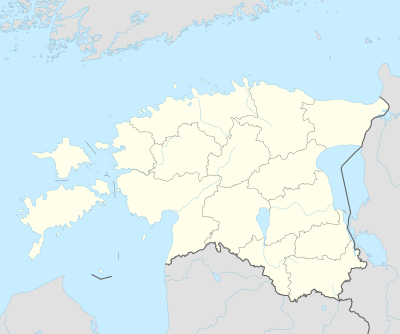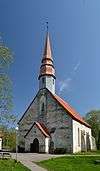Palamuse
| Palamuse | |
|---|---|
| Small borough | |
.jpg) Palamuse impounded lake on the Amme River. | |
 Palamuse Location in Estonia | |
| Coordinates: 58°41′05″N 26°35′03″E / 58.68472°N 26.58417°ECoordinates: 58°41′05″N 26°35′03″E / 58.68472°N 26.58417°E | |
| Country | Estonia |
| County | Jõgeva County |
| Municipality | Jõgeva Parish |
| First mentioned | 20.11.1234 |
| Population (01.01.2011[1]) | |
| • Total | 551 |
Palamuse is a small borough (Estonian: alevik) in Jõgeva County, in Jõgeva Parish, Estonia, located about 12 km (7 mi) southeast of the town of Jõgeva. It is passed by the Amme River. With a population of 551 (as of 1 January 2011)[1]
Palamuse was the biggest settlement and the administrative centre of Palamuse Parish.
Palamuse is best known for being depicted in the Oskar Luts' 1912–1913 novel Spring (Kevade) as the settlement called "Paunvere". The 1969 film adaptation Spring was also filmed in Palamuse. His brother, filmmaker Theodor Luts (1896-1980) was born in Palamuse.
Palamuse was first mentioned in a letter by Pope Gregory IX on 20 November 1234. The settlement evolved around the Palamuse St. Bartholomew's Church which was built in 1234 by the monks of the Kärkna Abbey. The church was reconstructed in Gothic style in the 15th century. Tower was added in the 19th century. In 1929 the church gained its today's interior.[2][3]
Gallery
 Palamuse church
Palamuse church Palamuse parish school, now the Palamuse Museum.
Palamuse parish school, now the Palamuse Museum. Palamuse Rectory
Palamuse Rectory War of Independence memorial
War of Independence memorial Goldberg villa
Goldberg villa.jpg) Amme river
Amme river Palamuse watermill
Palamuse watermill Palamuse pharmacy
Palamuse pharmacy
References
- 1 2 "Rahvastik" (in Estonian). Palamuse vald. Retrieved 10 August 2012.
- ↑ "Ajalugu" (in Estonian). Palamuse kogudus. Retrieved 11 August 2012.
- ↑ "Palamuse alevik" (in Estonian). eestigiid.ee. Retrieved 11 August 2012.
External links
| Wikimedia Commons has media related to Palamuse. |